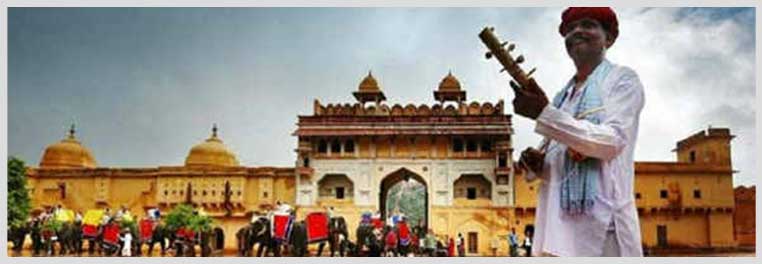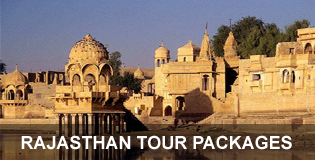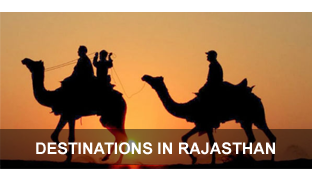Ajmer (Holy City)

The strategic position of this city has led to its turbulent history. Ajmer is connected to Delhi, Agra and Jaipur by main highways and holds the key to Gujarat and Malwa. It was a great centre of Chauhan power along with the twin capita.l of Delhi, but after Prithviraj Chauhan was defeated by Sultan Mohammed Ghori (1193), it had a chequered and violent history.
Ajmer has remained throughout, a great centre of pilgrimage for both Hindus and Muslims. And it is this feature that gives the city its character and lends it importance. Ajmer is a true amalgam of two rich cultures, the Hindu and the Islamic. The sacred lake of Pushkar, believed by Hindus to be as old as creation has the extant temple of Brahma, and Pushkar has been a place of pilgrimage throughout the history of India. The great Muslim divine Khwaja Moihuddin Chishti of Persia is buried here and his dargah is equally sacred for the followers of Islam. Emperor Akbar made an annual visit to the shrine of the Saint, sometimes on foot, as any ordinary pilgrim would.
In the heart of the city is the tomb of Saint Moihuddin Chishti (1142-1256). The mausoleum of Khwaja Moihuddin Chishti of Ajmer, popularly known as Dargah Sharif, has been since long a pilgrimage and spirtual centre where followers of almost every creed and faith, muslims, non-muslims, come throughout the year, especially on the occasion of the annual 'urs' celebrated from 1st to 6th Rajab. The shrine of Khwaja Moihuddin Chishti is considered, today, a second Mecca/Medina for the Muslims. The enormous gate of the mausoleum leading to the open court was built by Sultan Altamish (12th century). In the court are two gigantic iron cauldrons.
On the right is Akbar's mosque, a simple structure of dignified proportipns, made of white marble.
On top of the inner gate huge drums are kept in the Naubat Ghar or drum house. The inner gate was donated by a Nawab of Hyderabad. Several tombs take up the forecourt of this large inner enclosure.
In a far corner of the inner court is an elegant building. A long (30.5 metres) and narrow court with a low arcade in white marble which is delicately carved with trelliswork, it is the most beautiful of the buildings within the Dargah precincts.
The tomb of the Saint is in a square building of white marble with a large dome. It has two entrances. The front porch is covered with lamps and chandeliers donated by pilgrims.
Beyond the Dargah, among narrow and crowded lanes is a remarkable early Islamic structure.lt was originally a Sanskrit college, probably within a temple enclosure. En 1193, Mohammad Ghori took over Ajmer, destroyed the college and from its ruins, along with the remains of many nearby temples, hurriedly put together a mosque. Pillars from at least thirty temples must have gone into the making of this elegant and superb example of Indo-Islamic architecture.
Above the Adhai-din-ka-Jhonpra, the road turns into a bridle path, leading to the top of the hill on which the fort stands. One is rewarded by a fine view of the city.
Akbar's royal residence is now the museum which has an excellent collection of Moghul and Rajput armour-and some fine sculpture.
South-east of city is one of India's finest public schools, Mayo College. It was founded in 1875, originally only for the sons of Rajput royalty. Each heir to a state built his own house within the spacious college grounds covering 81 hectares which also housed his entire retinue along with his English tutor. The college is now open to all and is run on public school tradition.
'Formerly the British Residency, overlooks Ana Sagar Lake. From here the finest view of the lake can be had. One can also see the cenotaph and shrine of the Hindu reformer - Swami Dayanand Sarswati - who started the Arya Samaj movement in north India.
Excursions
An interesting drive,. 11 km to the west, takes one through a mountain pass to the holy lake of Pushkar. One of the mountains on this pass is called Nag Pahar or snake mountain where the Panchkund and cave of Saint Aghast Rishi is located. It is said that Kalidasa; the 4th century Sanskrit poet play-wright, placed the action of his masterpiece 'Shakuntala' in this forest hermitage. The lake has legendary origins. A lotus fell from the hand of Lord Brahma and dropped into this yalley. A lake sprang up on the spot, and was dedicated to Him. A temple to Brahma is on the farther place of pilgrimage.
About 1,00,000 pilgrims gather annually at Pushkar during the autumnal fair. This is also a livestock fair and thousands of horses, camels, cows and bulls are presented for. sale. At the time of the fair Pushkar blossoms into gaiety and colour. There are camel-cart races which everyone enjoys and are a delight to photgraphers.
Built by Raja Man Singh I of Amer, standing on the banks of Pushkar and is now a tourist bungalow. It is the most convenient place for visitors to stay, especially at the time of the fair.
12 km. Named after the engineer who built it, Foy Sagar is a picturesque artificial lake. It was the result of famine relief project.
| Area: | 55.76 sq. km. |
| Altitude: | 486 metres |
| Climate Mean Max: | Mean Mm |
| Summer: | 43.7CC 37.7*C |
| Winter: | 23.3CC 15.5°C |
| Rainfall: | 38 to 51 cm |
| Best Season: | July-March |
| Languages | English, Hindi, Urdu, Rajasthani |
| Local Transport City bus service operates round the city and Pushkar. Also unmetered taxis, auto-rickshaws, tongas, cycle-rickshaws | |
Travel Information
Air : Jaipur 131 km is the convenient airport.
Rail : Regular train services join Ajmer with important cities. Pink City Express from Delhi is a comfortable connection.
Road: A dense network of bus services operates from Ajmer to key destinations around.
In Ajmer, you find endless things that are truly Rajasthani and reflect an ancient mood. Silver and gold ornaments, jewellery, tie-and-dye sarees, embroidered Jodhpuri shoes are some of this city's specialities. 'During annual Urs fair, folk artisans display their calibre and offer a tempting range of intriguing and colourful items. Prominent shopping centres include Madar Gate, Station Road, Purani Mandi, Naya Bazar, Kaserganj, Nala Bazar.
STD Code 0145
Bank of Baroda Prithviraj Marg Tel 22575, Bank of Bikaner & Jaipur StatiOn Road Tel 23080, Bank of India Kaisarganj Tel 32153, Bank of Rajasthan Mayo College Tel 22424, Central Bank of India Tél 32496, Punjab Natioal Bank Prithviraj Marg Tel 20696, State Bank of India Near Collectorate Tel 20048.
JLN Hospital Tel 21470, 21521, Poly-Clinic Gattani Hospital Tel 50585
Ajmer Club Tel 20003
Assistant Director, Rajasthan Tourist Office, Hotel Khadim (RTDC) Tel 52426, TIB Counter at Railway Station
Approve guides may be hired through the Rajasthan Tourist Office, Tel. 52426






